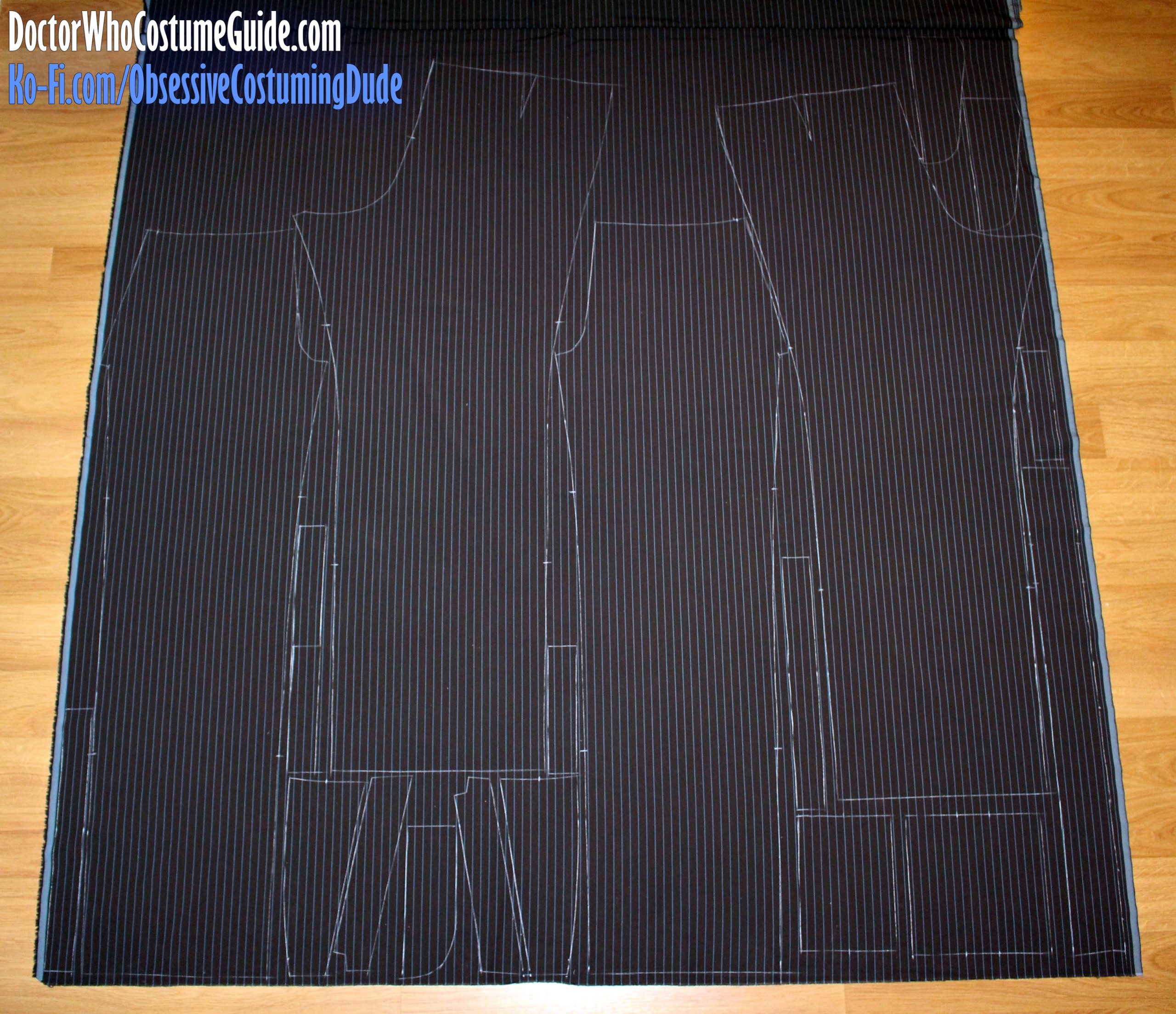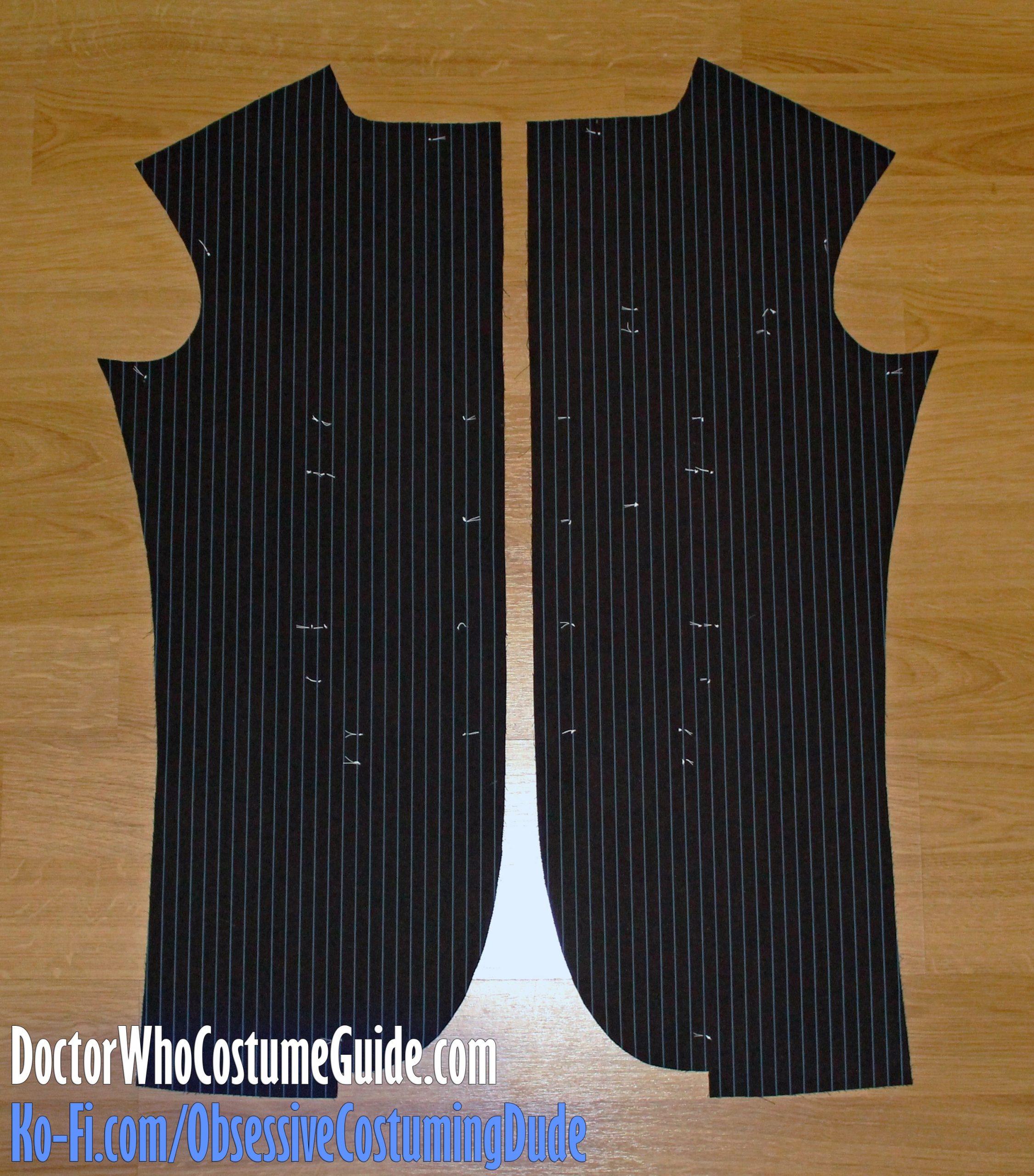SIZING INFORMATION
Here’s the sizing chart for the Tailors Gone Wild 10th Doctor suit sewing pattern:

On the printed pattern, the sizes above correspond to the following cutting lines:

If you’d like some help interpreting all the pattern information and learn some different methods for cutting out your fabric, you may find this free sewing lesson helpful. 🙂
PATTERN PIECES
NOTE: All pattern pieces include ⅝” seam allowance, unless otherwise noted.
JACKET:
A – Front
B – Front interfacing
C – Chest plastron
D – Chest flannel
E – Side panel
F – Back
G – Upper sleeve
H – Under sleeve
I – Front facing
J – Front lining
K – Side lining
L – Back lining
M1 and M2 – Upper collar
N1 and N2 – Under collar
O1 and O2 – Chest pocket flap
P1 and P2 – Chest pocket pouch
Q – Hip pocket flap
R – Hip pocket facing
S – Hip pocket bag
T – Back waistband
U – Interior pocket welt
V – Interior pocket bag
TROUSERS:
AA – Front
BB – Back
CC – Left waistband
DD – Right waistband
EE – Right fly
FF – Left fly
GG – Front pocket yoke
HH – Front pocket facing
II – Front pocket bag
JJ – Back pocket welt
KK – Back pocket bag
LL – Back pocket facing
MM – Belt loops
NN – Button tabs
As you may recall from my costume analysis, there were two different collar styles on the brown suit over the Davies/Tennant-era.
For the early version of the brown suit (with the front collar edge on a pinstripe), use collar pieces M1 and N1.

For the later version of the brown suit (with the slanted collar edge), use collar pieces M2 and N2.

In both cases, I suggest drawing a parallel line ⅝” from the upper collar’s front edge on the pattern piece (M1 or M2), to establish a reference for the collar’s front seam line.
Then, position the pattern piece over the fabric with the front seam line however you prefer – either on a pinstripe (for the early version), or crossing over a pinstripe (for the later version).
I also suggest drawing a parallel line ⅝” from the upper collar’s back edge, to establish a reference for the collar’s center back seam line.
Ideally, the center back should automatically either fall on a pinstripe, or exactly halfway between two pinstripes.
However, since this particular suit is fabric-specific, you may need to “cheat” a little bit in one direction or the other.
One way is to ease in a slightly larger collar, or stretch a slightly smaller one, just a tiny bit (say, 1/16” on each side).
A better way is to slightly adjust the jacket’s neckline to compensate, by taking in or letting out the center back and/or shoulder seams a tiny bit. (For example, if you have to extend the back edge of your upper collar by ⅛” so the seam line falls on or exactly halfway between two pinstripes, simply let out the center back seam at the neckline by ⅛”, or let out the shoulder seams at the neckline by 1/16”.)
Now that you have your materials gathered, determined your sizing, and decided on your jacket style …

CUTTING
After you’ve washed and pressed your fabric, cut out the suit jacket and trousers as indicated on the printed pattern, remembering to mark all balance lines and dots.
TIP: Use the pinstripe alignment guides on the printed pattern to ensure proper alignment while constructing the suit! (If you cut at random, it will likely be impossible to match the stripes at the appropriate seams/intersections.)
TIP: I prefer to unfold my fabric, lay it flat, and trace my pattern pieces with tailor’s chalk before cutting. This allows me to play Tetris with the pattern pieces and get the most value out of my yardage.
I recommend marking all dots (such as those for darts, pocket placements, buttons, etc.) with “tailor’s tacks” – that is, a small loop of basting thread at each dot.
As I mentioned in the “required materials,” for my suit jacket, I chose to bolster the lightweight cotton up a bit with some lightweight fusible hair canvas/hymo interfacings.
For the jacket fronts (piece A) and front facings (piece I), I used “Light Weight Deluxe Fusible Hymo 72” (T15-U)” from B. Black and Sons.
For the jacket side panels (piece E), back panels (piece F), and back waistband (piece T), I used “Light Weight Stretch Fusible Hymo” (T15-UU) from B. Black and Sons.
(However, in hindsight I would have used this for the jacket fronts as well, instead of the aforementioned.)





